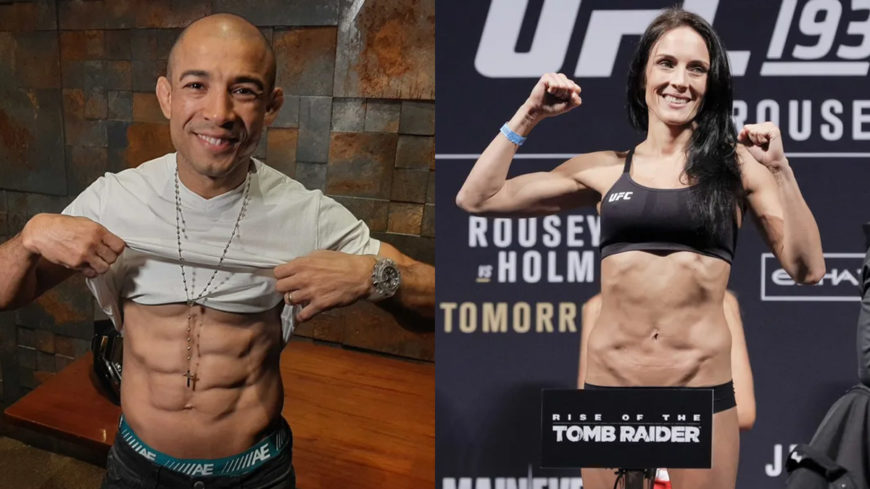Weight cutting refers to all the efforts fighters place themselves through to compete in weight classes in which their weight is below their normal, walking around weight.
Weight cutting is a controversial topic and fighters can suffer from unfortunate consequences as a result of it.
The weight cutting process consists of two steps:
- Losing weight during training camp is the main way in which fighters reduce their weight
- As the final days before the weigh-ins approach, water-weight is the last thing that is cut from their bodies
During the second phase, which is called the dirty phase, the fighter can sweat away as much as twenty percent of the weight of their body. The fighter is nearly dehydrated.
Water weight loss is the most efficient method for temporarily reducing your body weight enough to compete in a lower weight class as your body is primarily composed of water.
UFC Fighters: How Do They Cut Weight?
Fighters in the UFC make sure that they maintain a calorie deficit at all times during their camp while slowly losing weight. By limiting salt intake for a period of four to six days, they were able to reduce their final water weight to a desirable level. During this process, they usually use a sauna or hot bath and train while wearing sweatsuits to accelerate the process.
In the history of the fight game, weight-cutting has been a closely debated aspect since its origins as a boxing contest.
Promotions are unwilling to add more divisions to their events, so they must continue using this method despite it being harsh on the body.
UFC fighters have become accustomed to weight-cutting, and most of them make weight just hours before they compete in the octagon.
Some fighters have been able to dry out between 10% to 16% of their own weight in water in just four to six days by following these steps:
- Stay away from salt as it absorbs water.
- Before cutting, drink lots of water in order to flush the excess salt out of your body.
- Do not eat any carbohydrates for a couple of days to avoid unnecessary weight growth
- Diuretics (laxatives) may be used to help you lose weight faster.
- This can be done by taking hot baths or using saunas
- You may want to exercise in a sweat suit or in a sauna to reduce the final weight
In order to achieve a level playing field for all competitors, weight cuts are unfortunately a necessity. A 115-pound strawweight fighter cannot be expected to fight a 265-pound heavyweight.
Although it is not impossible, it would require a lot of hard work and skill to achieve. Considering the level of competition within the UFC, this would not be fair.
Conor McGregor official weigh in comparisons
Top – 154.4lbs for #UFC205
Bottom Left – 145lbs for UFC 194
Bottom Right – 168lbs for UFC 196 pic.twitter.com/AslaT2tNX5— Chamatkar Sandhu (@SandhuMMA) November 11, 2016
Read also: Worst And Most Dangerous Weight Cuts In UFC History
So why do fighters in the UFC cut weight?
Rather than competing against heavier opponents in their natural division, fighters cut weight in order to compete in a lower weight class. During the period between weigh-ins and the fight, fighters usually will regain about 8% of their body weight in water.
According to research, weighing more than your opponent within your weight class does not necessarily increase your chances of victory, rather it does little to enhance your chances of prevailing.
According to a recent study conducted by researchers in California, weight-cutting in Bellator had little or no impact on the win/loss statistics.
In the MMA world, a number of well-known figures, such as Joe Rogan, speak against extreme weight-cutting measures.
The idea is that by having more weight classes in the UFC, fighters wouldn’t feel any pressure to fight in lighter weight classes, and weight advantage wouldn’t really be an incentive.
The UFC doesn’t want its champions diluted, so it won’t happen any time soon.
Having fewer champions means you will be able to promote them more effectively, since their exclusivity will make them more valuable to promotion.
UFC Fighters: How Much Weight Do They cut?
During their training period leading up to a weigh-in, UFC fighters lose an average of 19.5 pounds. In fact, while training with a proper diet and a good training plan, fighters tend to lose most of their weight fairly slowly. In the days leading up to their weigh-in, they will drastically lower their water weight by employing more extreme methods to eliminate their remaining water weight.
This is a list of a bunch of UFC fighters who have drastically cut weight.
| Fighter | Normal Weight | Weigh-ins | After Weight Cut |
| Khabib Nurmagomedov | 187 lbs | 155 lbs | 32 lbs |
| Conor McGregor | 175 lbs | 155 lbs | 20 lbs |
| Dustin Poirier | 185 lbs | 155 lbs | 30 lbs |
| Kamaru Usman | 190 lbs | 170 lbs | 20 lbs |
| Jon Jones | 230 lbs | 205 lbs | 25 lbs |
| Alexander Volkanovski | 166 lbs | 145 lbs | 21lbs |
| Holly Holm | 155 lbs | 135 lbs | 20 lbs |
| Amanda Nunes | 162 lbs | 145 lbs | 17 lbs |
| Zhang Weili | 125 lbs | 115 lbs | 10 lbs |
| Joanna Jedrzejczyk | 125 lbs | 115 lbs | 10 lbs |
Weight cut will depend upon the division in which the fighter competes as well as the fighter’s actual walking weight. Fighters who are near the top of the class for their weight class have a greater chance of staying in their natural weight category.
Between weigh-ins and the moment they enter the octagon, fighters will usually regain lost water weight.
Ironically, by the time the fight actually begins, many fighters will have crossed the weight limit for their division.
Does every UFC fighter cut weight prior to a fight?
To compete in their preferred weight class, fighters often have to lose weight, but for some fighters, losing weight is not necessary at all. For an instance, When Israel Adesanya competes at Light Heavyweight, he can gain weight because he is a much lighter competitor than the average Heavyweight athlete.
Typically, Izzy fights in the Middleweight division, which requires little to no weight cutting. The case is not unique of fighters like Adesanya who are satisfied to compete at their natural weight and are happy to fight at that weight.
It is worth mentioning that he decided to not add any extra weight to his body when preparing to face Blachowics in UFC 259. Instead of bulking up, he decided to focus on developing his skills before the fight.
How Do Things Work Out If A UFC Fighter Can’t Make Weight?
Missing weight is a topic of contention among UFC fighters. Missing weight does not necessarily affect the fighter’s ability to compete, but the fighter will lose up to 30% of his prize money to his opponent. Missing weight during a title fight automatically disqualifies the fighter, even if they win the bout.
Missing weight repeatedly could mean moving up a division. For some fighters, missing the weight multiple times is enough to cause them to be expelled from promotion.
Fighters not making weight has spoiled many high-profile championship bouts. It opens up a whole new area of possibilities to be explored if an infringing challenger wins a championship.
Fans and the promotion have a difficult time dealing with a champion who’s beaten but still retains a belt. While some fans will support the unofficial champion, others will contest the legitimacy of the champ.
The challenge that fight promoters like Dana White have to deal with at this point is an incredibly complex one.
Additionally, there is another opportunity for pay-per-view revenue that is going to bring in great profits. Furthermore, pitting the champion against other fighters for the sake of defending their title would seem near meaningless.
It would take a legitimate rematch in order to set the balance right again.
As an added bonus, champions who managed to beat an ineligible opponent would be deemed more “deserving” of the throne.
How Does the Match Work If Both Fighters Miss the Weight Limit?
It is very rare for two fighters to miss weight in the UFC, and each case is handled individually. If a fighter doesn’t cut weight in time, or if he/she moves up in weight class or the fight is called off, there are a variety of possibilities. Dana White, the UFC’s promoter, makes the decision on this issue.
Recently, Tim Means (172.5 lbs) and Laureano Staropoli (174.5 lbs) missed the weight cap for their Welterweight fights, but Means was able to achieve the 171 lbs grace limit thanks to additional time to reduce weight.
Staropoli’s purse was reduced by 20% for failing to make weight, but the fight was still able to proceed. Fighting promotions have to deal with situations like this all the time.
Promoters may lose interest in fighters, leading to their inability to find fights in the future, causing them to change companies.
Are UFC fighters allowed to gain weight after weigh-ins?
A fighter may regain up to 10% of their body weight after weighing in successfully, according to the 10-point plan of the California State Athletic Commission. If a fighter weighs 170 lbs, they can rehydrate after weigh-ins and gain 17 lbs.
In 2017, the 10-point plan was formulated to curtail excessive weight loss. It is as follows:
- It must be given the go-ahead by a physician that they are qualified to compete in their respective weight classes
- It is a fine of 20% to be assessed to a fighter who misses weight. This fine will be shared between the opponent and the commission.
- It has been proposed that additional weight classes be added: 165 lbs, 175 lbs, 195 lbs, and 205 lbs
- Changes to match approval policies to focus more on weight classes that are appropriate
- Missing weight more than once means moving up to a higher weight class
- It is advisable to have early weigh-in procedures in order to provide fighters with sufficient time to rehydrate
- On the day of the fight, a second weight check is carried out to ensure fighters do not exceed the 10% weight regain limit
- CSAC physicians must check for dehydration by performing a urine gravity test or a physical
- For high-level titles bouts advertised, a 30-day and 10-day weight check is recommended.
- Educate Matchmakers, Promoters, Trainers, and Athletes on weight cutting and dehydration in relation to offering, accepting, and contracting of bouts.
Weight Cutting: Is It Dangerous?
Safe weight loss can be achieved if diet and exercise are done slowly throughout the training camp. Fighters who dehydrate themselves severely to shed the last few pounds can suffer fainting or even organ failure during weight cuts.
In most cases, fighters don’t have the appropriate nutritional coaches to assist them through this process, which leads them to suffer very serious harm, including but not limited to, Coma, seizures, kidney failure, heat stroke or exhaustion and cramps.
It’s the risk fighters take to meet these weight requirements that is the main problem with weight classes. Not only are they putting their lives at risk in the octagon, but they are also risking their lives outside of it.
Has anyone died as a result of Cutting weight?
In recent history, weight-cutting has directly resulted in two deaths in MMA. In 2013, Leonardo Souza passed away as he was preparing for his fight against Shooto Brazil 43, and in 2015, Yang Jian Bing passed away before he was to fight Geje Eustaquio at Flyweight for ONE Championship.
Weight cuts have been taken more seriously since these fighters’ untimely deaths.
Before the actual fight, cutting weight has become its own war, with competitors hiring health and fitness coaches to help them on their way to losing weight before weighing in.
UFC Weight Classes – Includes Men and Women
The following are the weight classes in which fighters will attempt to fit.
Men’s UFC weight classes
Weight Category Max. Weight
- Flyweight — 125-lb (56.7-kg)
- Bantamweight — 135-lb (61.2-kg)
- Featherweight — 145-lb (65.8-kg)
- Lightweight — 155-lb (70.3-kg)
- Welterweight — 170-lb (77.1-kg)
- Middleweight — 185-lb (83.9-kg)
- Light Heavyweight — 205-lb (93.0-kg)
- Heavyweight — 265-lb (120.2-kg)
Women’s UFC weight classes
Weight Category Max. Weight
- Strawweight — 115-lb (52.2-kg)
- Flyweight — 125-lb (56.7-kg)
- Bantamweight — 135-lb (61.2-kg)
- Featherweight — 145-lb (65.8-kg)








